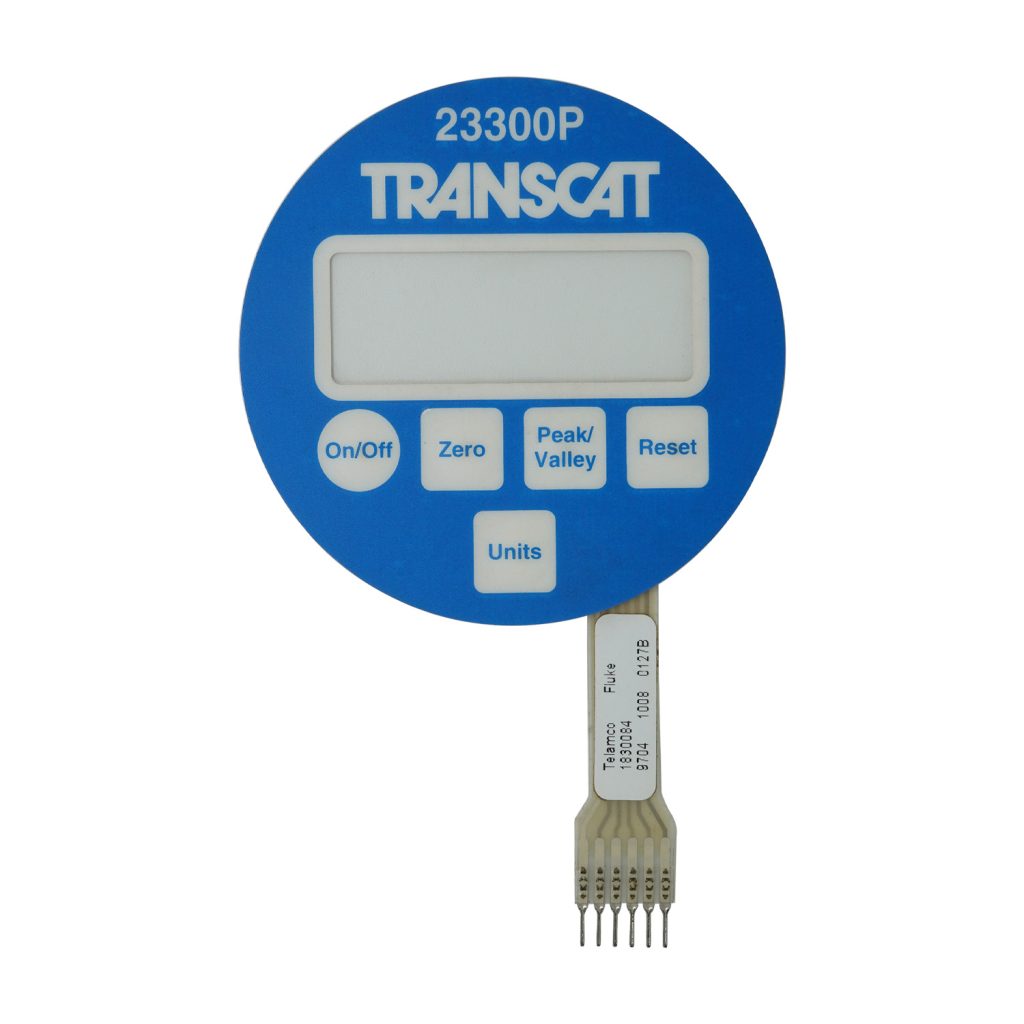Today, we will introduce a product that we cooperated with XINBIXI: TRANSAT pressure gauge. Pressure gauge is an instrument used to measure fluid and space pressure, and is widely used in various industrial, scientific research and medical fields. The membrane switch surface of TRANSAT pressure gauge is designed and produced by XINBIXI.

The following introduces the functional application of this pressure gauge and the design and production of the membrane switch:
Functional application of TRANSAT pressure gauge
1. Function
High-precision measurement: Pressure gauges usually have high precision and can accurately measure various pressure values.
Multiple measurement ranges: According to different application requirements, pressure gauges have different measurement ranges, including low pressure, medium pressure and high pressure.
Multiple output signals: The pressure gauge can convert the measured pressure value into a variety of output signals, such as 4-20mA current, 0-10V voltage or digital signal, which is convenient for connection and communication with various control systems and recording equipment.
Good stability: Pressure gauges usually have good stability and can maintain measurement accuracy and stability during long-term use.
Strong anti-interference ability: Some high-end pressure gauges also have anti-interference ability, which can maintain measurement accuracy in complex electromagnetic environments.
Easy to install and maintain: Pressure measuring instruments usually have a simple installation and maintenance process, which is convenient for users to perform daily operations and maintenance.
2. Application
Industrial automation: Measure the pressure of gas or liquid on the production line to ensure the stable operation of the production process.
Environmental monitoring: Measure parameters such as atmospheric pressure and water pressure to provide data support for weather forecasts, hydrological monitoring, etc.
Refrigeration and air conditioning: Perform pressure resistance, pressure holding tests, and vacuum leak tests to improve the scientific nature of product process inspections.
Petrochemical: Measure the pressure of equipment such as reactors and storage tanks to ensure production safety.
Water treatment: Monitor the pressure changes of equipment such as water pumps and pipelines to provide important data for water quality monitoring and pipeline network management.
Automobile manufacturing: Measure the pressure of components such as engines and brake systems to ensure the safety and performance of automobiles.
Aerospace: Measure the pressure inside and outside the aircraft to provide important guarantees for flight safety.
Design and production of TRANSAT membrane switches
1. Design
Requirement analysis: First, the XINBIXI design team needs to clarify the functional requirements and performance requirements of the TRANSAT pressure gauge, the number of buttons, layout, type of indicator elements, and style of the instrument panel.
Structural design: According to the functional analysis of the pressure gauge, determine the structural type of the membrane switch, such as single-layer, double-layer or multi-layer structure.
Material selection: Select a suitable film material as the substrate. Here, XINBIXI uses PET material, which has good wear resistance, high temperature resistance and stability, and is suitable for making membrane switches.
Circuit pattern design: Design the pattern of the conductive circuit and electrode of the pressure gauge to ensure that the circuit connection is correct and the performance is stable.
Drawing: According to the design requirements, draw detailed drawings, including the structure, size and position of each layer.
2. Production
Printing: Transfer the designed circuit pattern to the film material through printing technology. Common printing methods are screen printing and flexographic printing. During the printing process, it is necessary to ensure that the pattern is clear, the position is accurate, and the conductivity is good.
Production of bulge buttons and triggers: The size and shape of the bulge buttons are designed according to the size of the pressure tester. It also needs to be based on the natural characteristics and concave-convex characteristics of the PET material, and has strict temperature and pressure requirements.

The trigger is the core component of the membrane switch, which is used to detect and trigger the switch action. It is generally made of conductive materials, which can be conductive ink or metal foil. According to the design requirements, the corresponding shape and number of triggers are made.
Here the trigger will work with the bulge button.
Appearance processing: The appearance of the membrane switch is processed to meet the requirements of the appearance design, including cutting, punching, labeling and other steps. Cutting and punching can be performed using laser cutting or die cutting machines to ensure accuracy and efficiency.
Assembly: Assemble the processed membrane switch into the pressure measuring instrument. Including sticking the membrane switch to the corresponding position of the instrument, connecting the wires, fixing the switch, etc. During the assembly process, it is necessary to pay attention to the position and direction of the membrane switch to ensure its normal operation.
Performance testing: The performance of the manufactured membrane switch is tested, including static and dynamic tests. Static testing is to detect the conduction and disconnection of the switch, and dynamic testing is to simulate the use scenario to repeatedly trigger the switch to test its stability and durability.
Quality inspection: Perform quality inspection on the membrane switch to ensure that it meets the product requirements. The inspection content includes appearance quality, circuit connection, key feel, etc.
Cleaning and packaging: Qualified membrane switches can be sold or applied to corresponding products after cleaning and packaging.
3. Precautions
Sealing: Since pressure measuring instruments usually need to be used in various environments, the sealing of membrane switches is crucial. During the production process, it is necessary to ensure that the layers are tightly pasted without bubbles to prevent moisture and dust from entering.
Waterproof and dustproof: In order to improve the durability and reliability of the membrane switch, waterproof and dustproof measures need to be taken. For example, adding a waterproof film between the circuit layers or using waterproof glue.
Anti-static interference: In the design and production process of the membrane switch, attention should be paid to the problem of anti-static interference. Measures such as grounding and the use of anti-static materials can be taken to reduce the impact of static electricity on the circuit.